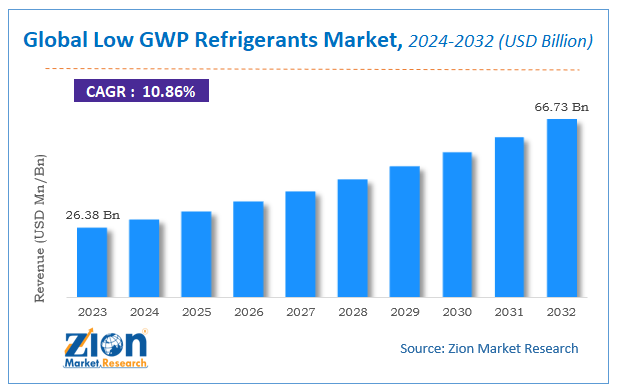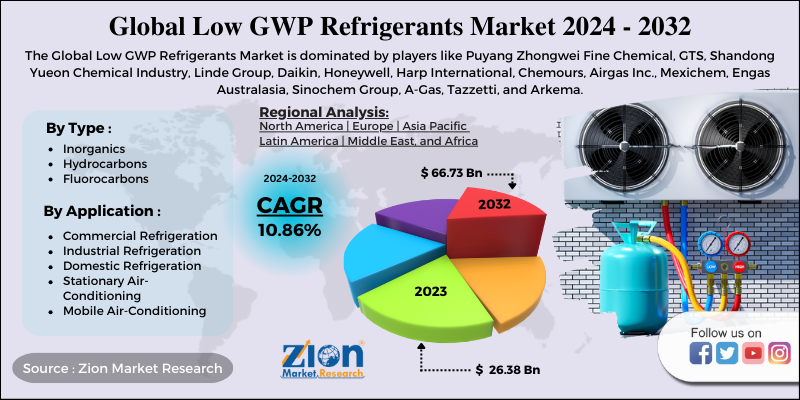Low GWP Refrigerants Market Size, Share, Trends, Growth 2032

Low GWP Refrigerants Market By Type (Inorganics [Ammonia, Carbon dioxide, and Others], By Hydrocarbons [Isobutane, Propane, and Others], and Fluorocarbons [HFCs, and HFOs)], By Application (Commercial Refrigeration, Industrial Refrigeration, Domestic Refrigeration, Stationary Air-Conditioning, Mobile Air-Conditioning, and Others), and by Region: Global Industry Perspective, Comprehensive Analysis and Forecast, 2024 - 2032
| Market Size in 2023 | Market Forecast in 2032 | CAGR (in %) | Base Year |
|---|---|---|---|
| USD 26.38 Billion | USD 66.73 Billion | 10.86% | 2023 |
Low GWP Refrigerants Market Insights
Zion Market Research has published a report on the global Low GWP Refrigerants Market, estimating its value at USD 26.38 Billion in 2023, with projections indicating that it will reach USD 66.73 Billion by 2032. The market is expected to expand at a compound annual growth rate (CAGR) of 10.86% over the forecast period 2024-2032.
The report explores the factors fueling market growth, the hitches that could hamper this expansion, and the opportunities that may arise in the Low GWP Refrigerants industry. Additionally, it offers a detailed analysis of how these elements will affect market demand dynamics and market performance throughout the forecast period.
Low GWP Refrigerants Market: Overview
Refrigerants are used in various kinds of heating, air conditioning, ventilation, and refrigeration (HVAC&R) devices. The current generation of refrigerants has zero ozone depletion potential. However, when released in the environment, they have significant Global Warming Potential (GWP). The rising emphasis on global warming mitigation has propelled the interest in a new generation of low-GWP refrigerants, thereby steering the low GWP refrigerants market expansion.
The key aspects of driving the market size are the reduced ecological effect of the products and the burgeoning popularity of air conditioners & refrigerants worldwide. Large-scale application of low GWP refrigerants in commercial refrigeration, domestic refrigeration, and industrial refrigeration will further impel the low GWP refrigerants market progression in the years to come. Furthermore, refrigerants that have a low GWP can be sufficient for bringing down emissions and this will contribute remarkably towards the expansion of low GWP refrigerants market earnings in the coming decade.
Low GWP Refrigerants Market: Growth Drivers
From a global perspective and as a part of corporate social responsibility & accountability, there is a massive industry inclination towards natural refrigerant solutions as they are both technically secured and economically viable. Today, there is a growing preference for new-low GWP refrigerants to minimize the ecological damage and this will boost the low GWP refrigerants market trends across the globe. These products help in achieving long term sustainability that will safeguard long-term investments in the market, thereby enhancing the scope of the business.
The report covers forecast and analysis of the market on a global and regional level. The study provides historic data of 2018 to 2022 along with a forecast from 2024 to 2032 based on revenue (USD Billion). To understand the competitive landscape in the market, an analysis of Porter’s Five Forces model for the aircraft engine market has also been included in the study. The report also analyzes several driving and restraining factors and their impact on the market during the forecast period. The study encompasses a market attractiveness analysis, wherein type segments are benchmarked based on their market size, growth rate and general attractiveness.
Low GWP Refrigerants Market: Segmentation
The low GWP refrigerants market can be sectored into type, and application.
Based on the type, the low GWP refrigerants market can be sectored into inorganics, hydrocarbons, and fluorocarbons.
Application wise, the market is classified into commercial refrigeration, domestic refrigeration, industrial refrigeration, stationary air-conditioning, mobile air-conditioning, and others.
Low GWP Refrigerants Market: Report Scope
| Report Attributes | Report Details |
|---|---|
| Report Name | Low GWP Refrigerants Market |
| Market Size in 2023 | USD 26.38 Billion |
| Market Forecast in 2032 | USD 66.73 Billion |
| Growth Rate | CAGR of 10.86% |
| Number of Pages | 110 |
| Key Companies Covered | Puyang Zhongwei Fine Chemical, GTS, Shandong Yueon Chemical Industry, Linde Group, Daikin, Honeywell, Harp International, Chemours, Airgas Inc., Mexichem, Engas Australasia, Sinochem Group, A-Gas, Tazzetti, and Arkema among others |
| Segments Covered | By Type, By Application And By Region |
| Regions Covered | North America, Europe, Asia Pacific (APAC), Latin America, Middle East, and Africa (MEA) |
| Base Year | 2023 |
| Historical Year | 2018 to 2022 |
| Forecast Year | 2024 - 2032 |
| Customization Scope | Avail customized purchase options to meet your exact research needs. Request For Customization |
Low GWP Refrigerants Market: Regional Analysis
Regionally, the low GWP refrigerants market is divided into Europe, Latin America, Asia Pacific, North America, and the Middle East and Africa. The European low GWP refrigerants market is slated to register humungous expansion over the assessment timeline, subject to the recent HFC phase out a plan that will help in the minimization HFC refrigerants applications by nearly fifty percent by end of 2025. The region has the large presence of end users who have already swapped to low GWP refrigerants from synthetic refrigerants. The U.S. government, as well as the industry participants in the country, is trying to reduce GHG emissions as a result of growing concerns over global warming. This, in turn, has resulted in escalating demand for the product across the region, thereby driving the low GWP refrigerants market trends in North America. Reportedly, the Building Technologies Office (BTO) in carrying out its activities under the auspices of the U.S. Department of Energy (DOE) Office is promoting energy efficiency and green energy and succors the development, appraisal, and widespread enforcement of low-GWP refrigerants.
Part of BTO strategy is to develop and implement technology blueprints and plans that help in market transformations and develop innovations in key technology areas such as working fluids. The organization is trying to develop next-generation low-GWP refrigerants in order to maintain or improve the energy efficiency performance of HVAC&R equipment. This will further drive the low-GWP refrigerants market evolution in the U.S.
Low GWP Refrigerants Market: Competitive Analysis
The global low gwp refrigerants market is led by players like:
- Puyang Zhongwei Fine Chemical
- GTS
- Shandong Yueon Chemical Industry
- Linde Group
- Daikin
- Honeywell
- Harp International
- Chemours
- Airgas Inc
- Mexichem
- Engas Australasia
- Sinochem Group
- A-Gas
- Tazzetti
- Arkema
The report segments the global low GWP refrigerants market into:
Global Low GWP Refrigerants Market: Type Segment Analysis
- Inorganics
- Ammonia
- Carbon dioxide
- Others (Air, and Water)
- Hydrocarbons
- Isobutane
- Propane
- Others (Butane, Propylene, Ethylene, and Ethane)
- Fluorocarbons
- HFCs
- HFOs
Global Low GWP Refrigerants Market: Application Segment Analysis
- Commercial Refrigeration
- Industrial Refrigeration
- Domestic Refrigeration
- Stationary Air-Conditioning
- Mobile Air-Conditioning
- Others (Chillers and Water Heat Pumps)
Global Low GWP Refrigerants Market: Regional Segment Analysis
- North America
- The U.S.
- Canada
- Europe
- France
- The UK
- Spain
- Germany
- Italy
- Rest of Europe
- Asia Pacific
- China
- Japan
- India
- South Korea
- Southeast Asia
- Rest of Asia Pacific
- Latin America
- Brazil
- Mexico
- Rest of Latin America
- Middle East & Africa
- GCC
- South Africa
- Rest of Middle East & Africa
Table Of Content
Methodology
FrequentlyAsked Questions
Low-GWP refrigerants are those that have a low Global Warming Potential (GWP) and are made to have as little of an environmental effect as possible by contributing less to global warming when they are discharged into the atmosphere. The greenhouse gas potential (GWP) is a measurement of the amount of heat a gas traps in the atmosphere in relation to carbon dioxide (CO2), which has a GWP of 1.
International accords like the Montreal Protocol's Kigali Amendment seek to gradually phase out the use of high greenhouse gas (GWP) refrigerants like HFCs while encouraging the use of low GWP substitutes. Industries are being forced by these rules to switch to greener refrigerants.
Zion Market Research has published a report on the global Low GWP Refrigerants Market, estimating its value at USD 26.38 Billion in 2023, with projections indicating that it will reach USD 66.73 Billion by 2032.
The market is expected to expand at a compound annual growth rate (CAGR) of 10.86% over the forecast period 2024-2032.
Regionally, the low GWP refrigerants market is divided into Europe, Latin America, Asia Pacific, North America, and the Middle East and Africa.
Some of the players of low GWP refrigerants market included in report are Puyang Zhongwei Fine Chemical, GTS, Shandong Yueon Chemical Industry, Linde Group, Daikin, Honeywell, Harp International, Chemours, Airgas Inc., Mexichem, Engas Australasia, Sinochem Group, A-Gas, Tazzetti, and Arkema among others.
RelatedNews
HappyClients
Zion Market Research
Tel: +1 (302) 444-0166
USA/Canada Toll Free No.+1 (855) 465-4651
3rd Floor,
Mrunal Paradise, Opp Maharaja Hotel,
Pimple Gurav, Pune 411061,
Maharashtra, India
Phone No +91 7768 006 007, +91 7768 006 008
US OFFICE NO +1 (302) 444-0166
US/CAN TOLL FREE +1 (855) 465-4651
Email: sales@zionmarketresearch.com
We have secured system to process your transaction.
Our support available to help you 24 hours a day, five days a week.
Monday - Friday: 9AM - 6PM
Saturday - Sunday: Closed






